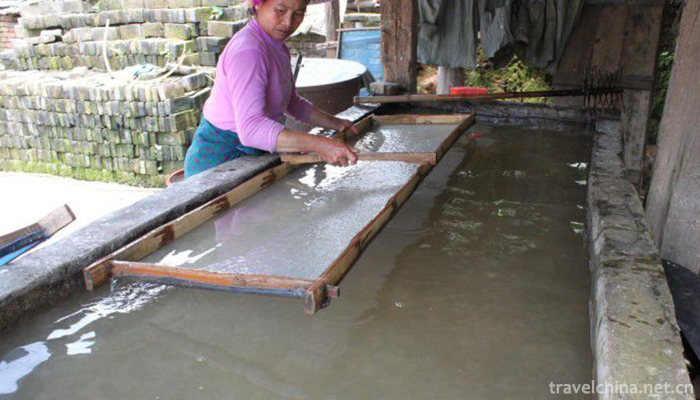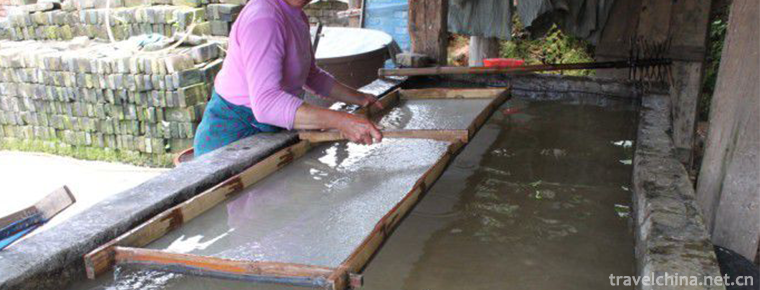Manufacturing Techniques of Tussah Paper
Manufacturing Techniques of Tussah Paper
The manufacturing history of tussah paper is as long as that of linen paper. The raw material for making the paper is the phloem fibers of the tree. The bark of the tree contains wood phloem fibers which are very suitable for papermaking.
On June 7, 2008, the paper was approved by the State Council to be included in the second batch of national intangible cultural heritage list.
Orion of the Name
Because of its long history and suitable for high-level painting and calligraphy, it has been paid special attention by literati. Sometimes the word "chu" becomes the symbol of paper. For example, Zhang Yi (1237-1368) wrote in his poem "Wood and Stone Pictures" for Zhao Mengfu, a contemporary Wuxing calligrapher and painter (1254-1322): "Wu Xing's brushwork is wonderful, and there are no people left behind. A piece of paper is a piece of paper. Xu Wei (1521-1593), a Ming Dynasty painter, said in"Painting Crane Fus": ink is like work, and life-long fun. Here the ink is paper ink, which means that if the ink and paper are made fine, it can be appreciated for a lifetime after being painted and calligraphed. Other scholars took it as their subject matter and personalized it into a funny biography.
Improvement
Technological improvement in the Ming Dynasty was a major stage of Chinese handmade paper. The manufacture of tussah paper was particularly prominent. It was produced in almost all parts of the country. It was suitable for various purposes. Its output, quality and processing technology reached an unprecedented high level.
During this period, there were also detailed documentation about the manufacture of paper. Dazhi of Jiangxi Province, edited by Wang Zongmu (1523-1591) of the Ming Dynasty in 1556? Chu Shu Chapter is the earliest work in the world to discuss in detail the manufacture of Chu Paper.
Dazhi of Jiangxi Province mainly records the technology of making paper in Yushan County, Guangxinfu Prefecture of Jiangxi Province (now Shangrao area) during Hongwu Period. According to Mr. Pan Jixing's research, the technological process of this kind of paper is as follows: immersing the material in water for several days, bundling it into small handles, boiling it in clean water, cutting the inner bones, pulling the bark into silk, cutting the bark into small bundles with knives or axes, soaking it with lime pulp, and storing it for the rest of the month, soaking it with lime pulp. Cooking in the pot taking the material out of the pot, rinsing the water naturally for several days in the cloth bag with river water treading to limewater pestle spread on the ground or hillside in the sun and rain, until color white using treadle or pestle mortar to make fine adding boboiled grass wood ash water on the pestle material to bubble, half a month dry river water washing material re-boiling water into the pot again into the boiling water to boiling in the pot again._Exposure to sunlight_Hand handling of secondary materials and miscellaneous materials Quality rejection fine chopping with knife, until crushed into pieces washed in the inner bag mixing with water into the tank adding paper to the tank salvaging paper pressing water drying of the fire wall uncovering paper from the wall trimming and packing. This method includes four times of cooking, including two times of fresh water cooking and two times of alkaline solution cooking. After this treatment, the paper is white as jade, the fibers are even and fine, and the surface is smooth, but it takes a lot of time and labor. The rulers never care about the cost of paper.
In addition to Jiangxi Dazhi, Huizhou Zhi (1502), edited by Peng Ze of Ming Dynasty, and Tiangong Kaiwu, edited by Song Yingxing, also have some technical records on paper, but they are relatively simple and less formalities.


-
1.China Railway HighSpeedCRH
China Railway High-Speed (CRH) has two meanings: the technical standard of China High-Speed refers to the passenger dedicated line railway with 250 km/h
Time 2018-11-13 -
2.Wanjiazhai Water Conservancy Scenic Area of the Yellow River
Wanjiazhai Water Conservancy Project is located in the canyon of the north main stream of the Yellow River from Toketo to Longkou. It is the first of eight cascades planned and developed in the middle
Time 2019-01-18 -
3.han opera
Guangdong Hanju Opera, formerly known as "Ran Tan", "Waijiang Opera" and "Xingmei Hanju Opera", is one of the Hakka Opera genres in Guangdong Province
Time 2019-05-01 -
4.Stir fried pork with salted vegetables
Stewed pork with dried plum is a famous traditional flavor dish in Shaoxing, Zhejiang Province. The main raw materials are dried plum and streaky pork. Dried vegetables absorb meat fat to remove astri
Time 2020-03-18 -
5.Jiufeng Mountain Scenic Area
Jiufeng Mountain is located in Dabao Township in the northwest of Pengzhou. It is about 97 kilometers away from Chengdu, with an altitude of more than 3315 meters. It is the crown of Pengzhou mountains, a sacred and mysterious area
Time 2020-11-05 -
6.The situation of Chinese embroidery in various historical dynasties
The origin of Chinese embroidery is very early. It is said that "Shun ordered Yu to embroider multicolored embroidery". It was developed in the Xia, Shang, Zhou Dynasties and Qin and Han Dynasties. From the early unearthed textiles, embroidery
Time 2020-12-12 -
7.Environmental protection in Mianyang
In 2018, the water quality of Fujiang, Kaijiang, Zijiang, Anchang River, Furong River, Tongkou River and Luban reservoir in Mianyang City accounted for 100% of the total water quality. Among them, Fujiang River, Tongkou River, Zijiang River and Anchang
Time 2020-12-14 -
8.Neijiang cultural undertakings
By the end of 2019, there are 121 performing arts venues in Neijiang City, including 6 cultural venues. There are 5 museums, 5 cultural relics protection and management institutions, 7 national key cultural relics protection units, 42 provincial cultural relics
Time 2020-12-16 -
9.Animal resources in Meishan
There are many species of wild animals in Meishan City, and the floristic composition is more complex, mainly subtropical forest animals. There are 469 species of terrestrial wild (vertebrate) animals, including 91 species of mammals, 18 orders, 27 families, 65 genera,
Time 2020-12-18 -
10.Meishan City logo
Meishan City logo is composed of ancient Chinese tile pattern and Dongpo head portrait, which shows a feeling of ancient historical traces and reflects the ancient culture of Meishan. From the design to the font are used a simple style, using the combinatio
Time 2020-12-18 -
11.Yibin water resources
Yibin city produces 614500 cubic meters of water per square kilometer per year. In addition to the amount of water from various rivers in the city, the city has a total annual water volume of 242.84 billion cubic meters, and the average annual water occupatio
Time 2020-12-18 -
12.Yibin scenic spot
South Sichuan Bamboo Sea is a national AAAA tourist attraction, covering an area of 120 square kilometers and a core scenic area of 44 square kilometers. There are eight main scenic areas, two major scenic spots and 134 scenic spots. In 2009, it was se
Time 2020-12-18